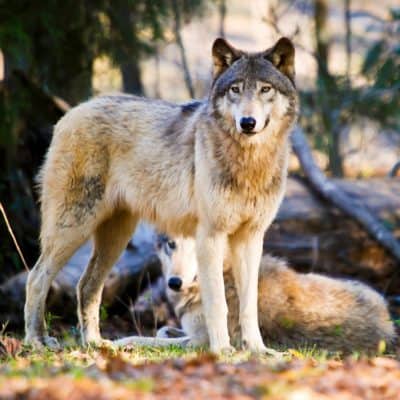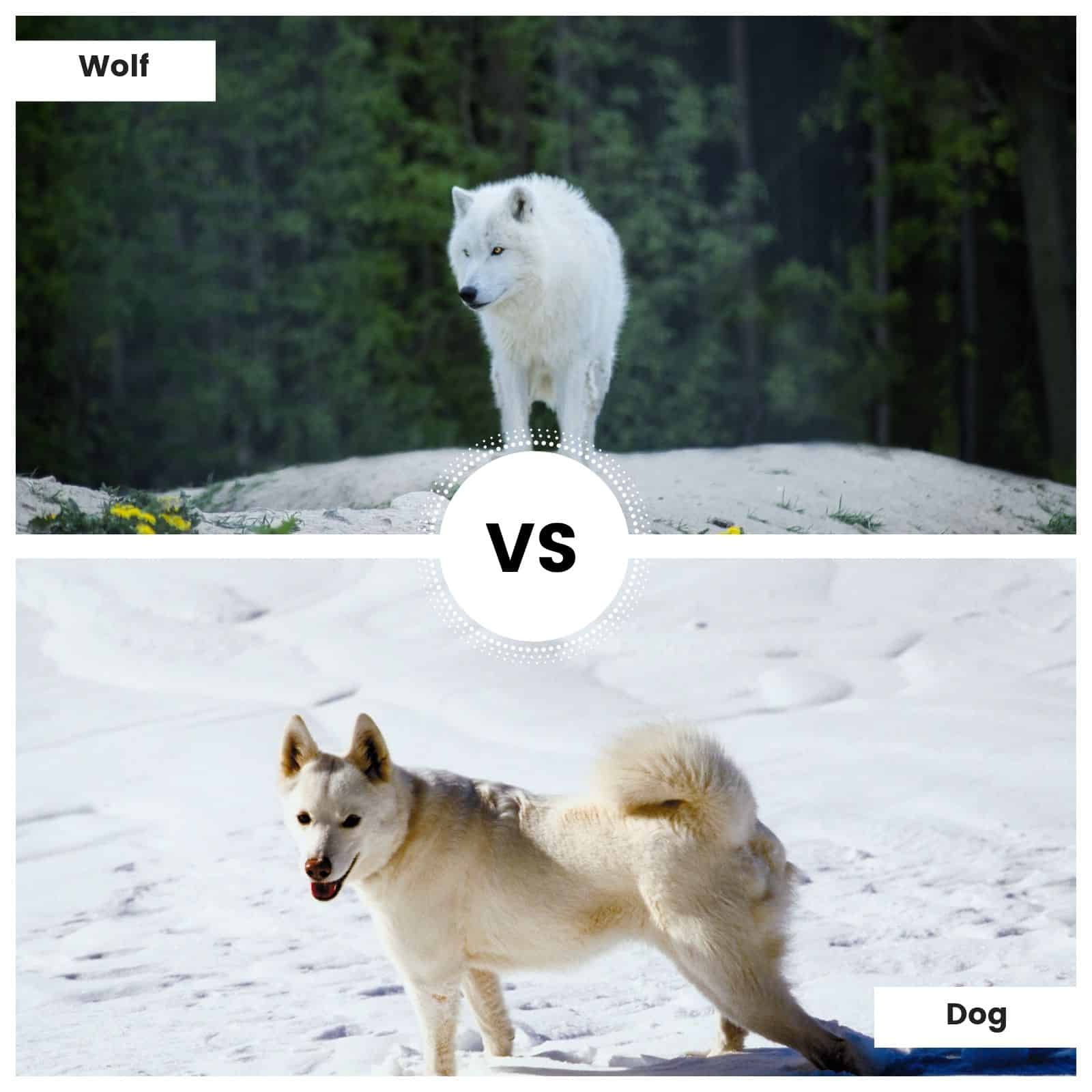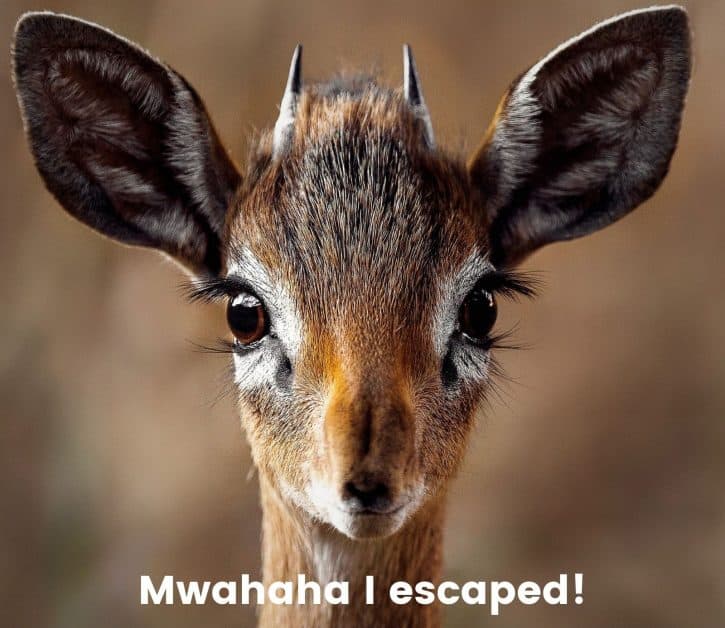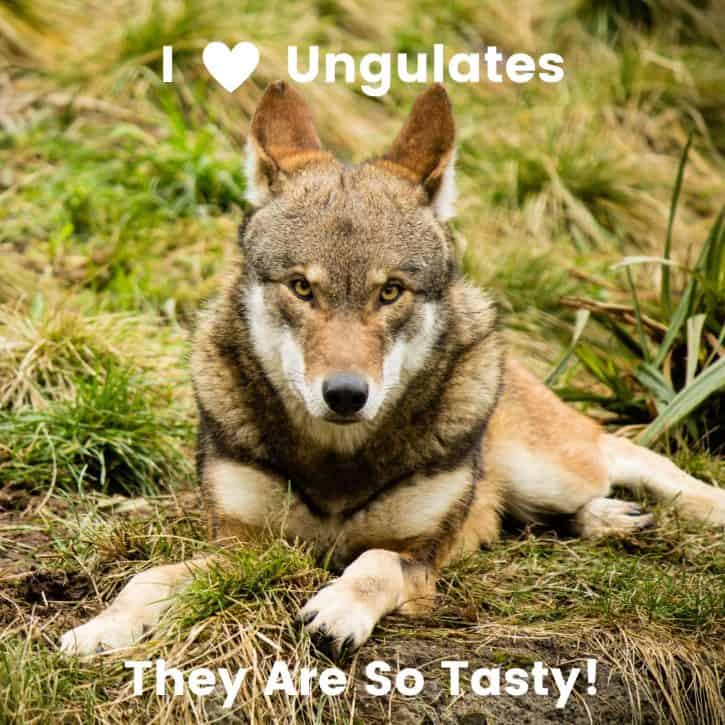What Do Wolves Eat?
July 6, 2020May 22, 2019 by C.B. Daniels


The Short Answer: Wolves are carnivores (meat eaters) who primarily eat large ungulates (hoofed animals) such as deer, moose, and elk.
Now that we’ve given you the short answer, here is the long answer…
Contents
1.1 The Difference Between Wolves and Dogs
1.1.1 Let’s look at some of the major differences between wolves and dogs.
2.1 How Do Wolves Get Their Food?
2.2 What Do Baby Wolves (Pups) Eat?
What Are Wolves?
Wolves are mammals from the genus Canis which includes dogs, jackals, coyotes, and dingoes.
There is quite a lot of debate over how many species of wolf there are due to how genetically similar most wolves are. However, there are two main species that are universally accepted: the gray wolf (also known as the common wolf or the timber wolf) and the red wolf.
Gray wolves are the larger of the two and are more common. They are found all over the world and in many different habitats from desserts to grasslands.
Red wolves are the smaller of the two and are much less common. They are found primarily in the southeastern part of the United States.
Not So Fun Fact: Red wolves were declared extinct in the wild in 1980, and the current population of red wolves is listed as critically endangered.
Despite their name, gray wolves come in a variety of colors including white, black, gray, and brown. They are typically a mixture of gray and brown.
Red wolves, as their name implies, have reddish tinted fur that is primarily tawny brown or gray. Because of their reddish coloration, red wolves are often mistaken for foxes.
Wolves are the largest living members of the Canid (dog) family and are the direct ancestors of modern-day dogs. They are known for their distinctive howling, and the image of a wolf howling at the moon is quite iconic (although not quite accurate).
Wolves howl as a form of communication, and they primarily howl at dawn and dusk (whether it is a full moon or not), because that is when they are most active.
Due to their similarity to dogs, many people are fascinated by wolves, and they are incredibly popular.
Fun Fact: The word canis means “dog” in Latin.
The Difference Between Wolves and Dogs

Although dogs are sometimes confused for wolves (especially huskies and German shepherds), there are some important differences between them.
Domesticated dogs are thought to be descended from a common, now extinct wolf ancestor.
Genetically, dogs can be considered a subspecies of the modern gray wolf, since they are 99.96% genetically identical. Although, there is some debate over whether they should be considered a separate and distinct species.
Regardless, they are similar enough genetically, that wolves and dogs can interbreed and produce hybrid offspring (unlike, say, dogs and foxes).
So why are dogs considered man’s best friend and wolves considered a threat?
Well, a lot of that has to do with that 0.04% difference in DNA.
It may seem like a small amount, but this difference is what makes dogs less aggressive and tamer than their wolf counterparts. (It is also what allows them to digest more carbs and fats than wolves can.)
Let’s look at some of the major differences between wolves and dogs.
- Wolves have larger, stronger jaws and teeth. Both wolves and dogs have 42 teeth, but wolves’ teeth are more curved, and they have the largest bite pressure of all the canids.
- Wolves have smaller chests, hips, and eyes than dogs do.
- Wolves have longer legs and ankles than dogs do, which probably explains why wolf pups can outrun grown dogs.
- Wolves have much larger feet than dogs do, and their front middle toes are much longer than their side toes, unlike dogs’ toes. Wolves also do not have sweat glands in their paws like dogs do.
- Wolves have more pointy ears, and longer, straighter tails than dogs do.
- Wolves have larger skulls and brains than dogs do. This might explain why wolves cannot be trained (they are probably laughing on the inside at the silly humans ordering them about).
- Wolves only breed once a year, but dogs can breed several times a year. Most dogs breed twice a year, but some smaller breeds will breed three times a year.
- Wolves mature faster than dogs, which makes sense when you think about it. Fido probably didn’t have to hunt for his own food when he was six months old. The wilderness will really toughen you up!
- Wolves are carnivores, but dogs are omnivores that can eat both meat and plants. Dogs also cannot eat the large quantities that wolves can because their digestion is different.
- Wolves are much shyer than dogs. In fact, contrary to their portrayal in media, wolves will actively try to avoid humans. Dogs, on the other hand, are quite bold and have no natural fear of humans.
Fun Fact: Wolves’ bite pressure is about 1,500 pounds per square inch which is almost twice as much as that of a German shepherd (and about five times that of a human being).
So, while they can appear physically similar (and are genetically similar), please keep in mind that wolves do not make good pets.
When they are younger, they can appear quite tame and obedient, but once they mature sexually, wolves become unmanageable. If you are looking for a pet dog that is similar in appearance to a wolf, look for an Akita, an Alaskan malamute, a husky, a German shepherd, or a Samoyed.
At the end of the day, wolves belong in nature and not as pets.
Fun Fact: Both wolves and dogs will eat grass if their stomachs are upset.
What Do Wolves Eat?
Wolves are carnivores, which means that they eat meat.
Their preferred prey are ungulates, which are large, hoofed animals such as deer, moose, and elk. However, they will also eat smaller prey such as rabbits, fish, birds, or even insects.
In desperate times, wolves have even been known to eat fruits and vegetables, although they do not derive enough nutritional value from these to survive.
Since gray wolves are larger, they typically go for larger prey than red wolves do. So, gray wolves are more likely to go for deer, but red wolves are more likely to go for rabbits.
Fun Fact: Wolves are in the order Carnivora which consists of, as the name implies, carnivores.
How Do Wolves Get Their Food?
Wolves are opportunistic predators, which means that they will eat whatever they come across (as opposed to ambush predators that lie in wait or lay traps). They hunt as a pack which is just a group of two or more wolves.
Most of the wolves’ preferred prey (ungulates) can easily outrun them, so instead, they rely on their cunning and stamina to catch them.
Wolves are incredibly smart and often herd their prey to areas where they can be taken down more easily. For instance, wolves have been known to herd their prey into ravines or onto deep snowbanks to slow them down.
However, the main resource that wolves rely on is their stamina. Their long legs and narrow chests are built for running long distances. In fact, wolves can run up to 25 mph for about 2 miles. Their top speed is about 45mph, but this can only be maintained for short periods of time.
Wolves will often take turns chasing down their prey in order to better tire them out. This is how an 80 lb. wolf can take down a 2,000 lb. bison!
Wolves also rely heavily on pack co-operation and communication. Unlike in the movies, wolves do not howl, snarl or bark at their prey to threaten it. This behavior is typically reserved for other wolves.
Fun Fact: Wolves’ howls can carry up to 10 miles in open areas and around six miles in wooded areas.
Instead, wolves are often silent when hunting, and rely on nonverbal signals such as facial expressions or body posture to communicate. Often, they do not need to communicate at all, because they each already know their roles when it comes time for the chase.
The main MO that wolves use to capture their prey is to separate them from their herd and then tire them out.
Wolves often go for weak or injured prey that is easier to kill although they will go for healthier prey if they see an opportunity.
While killing as a pack seems like it would be easy, it is in fact quite dangerous. Wolves can easily be kicked by hooves or gutted by antlers. A well-placed kick can shatter a wolf’s jaw.
Also, typically only part of the pack participates in the kill, and many of the members just watch from the sidelines. This is how the younger wolves learn to hunt.
Even though the pack members have different parts to play, all the members eventually eat. Contrary to popular belief, the alpha does not always eat first. Instead, the hungriest member is often allowed to eat first.
Unfortunately, hunts are often unsuccessful. It is estimated that only around 14% of hunts are successful. That’s a crazy low number!

This means that wolves often go hungry and must fast. Thankfully, they can go one to two weeks without food.
Because of the unreliability of their food, wolves will often gorge when they have a successful hunt. In fact, they can eat about 20 pounds of meat in one sitting. That gives new meaning to the phrase wolfing it down!
Wolves also practice food caching (also called hoarding) just like squirrels do. If wolves cannot eat all their food at once, they will often hide it, and scent mark the area to come back to later so that other predators do not eat it.
Wolves typically eat every five to six hours when food is readily available, and they eat almost all the body except the large bones, the skull, and the stomach contents. They even break apart the bones to get at the marrow. That is dedication!
So, if wolves eat almost all their prey, why do they need to hoard leftovers?
That’s because wolves also practice what is called surplus killing, which is where they kill more prey than they can eat and hoard it for later. This may seem cruel or unnecessary, but because they often go hungry, wolves will take food whenever they can get it. It’s a hard life for a wolf!
Also, wolves must often travel great distances in search of prey. They can even go as far as 50 miles in one day just looking for food. If you had to travel that far for a cheeseburger, you would hide it too.
Fun Fact: Wolves have been known to follow ravens to dead animals so that they can eat. They are smart cookies!
What Do Baby Wolves (Pups) Eat?
Baby wolves are called pups (or sometimes cubs) and have a different diet than adult wolves do.
Wolves reproduce in late winter, and often only the alpha male and his mate will have pups.
Fun Fact: Wolves usually mate for life.
Female wolves gestate for a period of about nine weeks and then give birth to a litter of pups that can range anywhere from 1-10 pups (although the average is five pups per litter).
When they are first born, the pups drink their mother’s milk, but they start to be weaned at around four to five weeks old. Because of their close-knit social bonds, all pack members will take turns feeding the pups once they can eat solid food.
Also, while the pack is away hunting, a pack member is always left behind as a babysitter in order to protect the pups.
Once the pups start eating solid food, the pack members will bring back food and regurgitate it for the pups to eat. While this may seem disgusting to us humans, it is very practical for wolves.
Wolves cannot easily carry food in their jaws over long distances, so instead, they carry it in their stomachs. Also, since the food is regurgitated, it is easier for the pups to digest. It’s a win-win!
Once the pups are about six months old, they will begin hunting. At two years old they are considered adults and can choose to leave the pack to look for mates.
Fun Fact: Wolves are born with blue eyes, but they change color when the pups are about six to ten weeks old. Adult wolves do not have blue eyes. Teen Wolf, you are a liar!

Wolf Food Options
Here is a list of wolf food options that includes both larger and smaller prey:
- Beavers
- Birds
- Bison
- Caribou
- Cattle
- Deer
- Elk
- Fish
- Insects
- Rabbits
- Rodents
- Moose
- Mountain Goats
- Muskoxen
- Sheep
Summary

Wolves are carnivores (meat eaters) who primarily eat large ungulates (hoofed animals) such as deer, moose, and elk.
There are two main species of wolves that are universally accepted: the gray wolf and the red wolf.
Although they are genetically similar, there are some differences between wolves and dogs:
- Wolves have larger, stronger teeth than dogs do.
- Wolves have smaller chests, hips, and eyes than dogs do.
- Wolves have longer legs and ankles than dogs do.
- Wolves have much larger feet than dogs do, and their front middle toes are much longer than their side toes, unlike dogs’ toes.
- Wolves have more pointy ears, and longer, straighter tails than dogs do.
- Wolves have larger skulls and brains than dogs do.
- Wolves only breed once a year, but dogs can breed several times a year.
- Wolves mature faster than dogs do.
- Wolves are carnivores, but dogs are omnivores that can eat both meat and plants.
- Wolves are much shyer than dogs.
Wolves are opportunistic predators, which means that they will eat whatever they come across, but they prefer ungulates (hoofed animals).
Wolves rely on their cunning and stamina to outrun and outmaneuver their prey. The main MO that they use to capture their prey is to separate them from their herd, and then tire them out.
Wolves also practice food caching (also called hoarding) which is where they hide their food and come back later to eat it. This is because they also practice surplus killing, which is where they kill more prey than they can eat in one sitting.
Baby wolves are called pups (or sometimes cubs) and start off drinking their mother’s milk. Once they can eat solid food, different pack members will bring them regurgitated food so that they can eat.
More animal articles you might enjoy:
Hi my name is C.B. Daniels and I make websites. I’ve also always been fascinated by animals. I thought that some of the information about animal diets and pet names was a little thin. So I figured I’d make this site to remedy that! I hope to make this site a hub for information about what animals eat, fun names you can use for your pets, and general animal information. Hopefully, you’ll find all the information about animals you are looking for and much more!
Latest posts by C.B. Daniels (see all)
- Can Rabbits Eat Grapes? - November 12, 2022
- Can Rabbits Eat Cucumbers? - November 3, 2022
- Can Rabbits Eat Spinach? - November 3, 2022